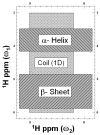Characterization of protein secondary structure from NMR chemical shifts
- PMID: 20160946
- PMCID: PMC2766081
- DOI: 10.1016/j.pnmrs.2008.06.002
Characterization of protein secondary structure from NMR chemical shifts
Figures












Similar articles
-
Predicting the redox state and secondary structure of cysteine residues using multi-dimensional classification analysis of NMR chemical shifts.J Biomol NMR. 2016 Sep;66(1):55-68. doi: 10.1007/s10858-016-0057-6. Epub 2016 Sep 9. J Biomol NMR. 2016. PMID: 27613298
-
2DCSi: identification of protein secondary structure and redox state using 2D cluster analysis of NMR chemical shifts.J Biomol NMR. 2007 May;38(1):57-63. doi: 10.1007/s10858-007-9146-x. Epub 2007 Feb 27. J Biomol NMR. 2007. PMID: 17333485
-
Unraveling the meaning of chemical shifts in protein NMR.Biochim Biophys Acta Proteins Proteom. 2017 Nov;1865(11 Pt B):1564-1576. doi: 10.1016/j.bbapap.2017.07.005. Epub 2017 Jul 15. Biochim Biophys Acta Proteins Proteom. 2017. PMID: 28716441 Review.
-
CSSI-PRO: a method for secondary structure type editing, assignment and estimation in proteins using linear combination of backbone chemical shifts.J Biomol NMR. 2009 Aug;44(4):185-94. doi: 10.1007/s10858-009-9327-x. Epub 2009 Jun 16. J Biomol NMR. 2009. PMID: 19529884
-
Chemical shift-based methods in NMR structure determination.Prog Nucl Magn Reson Spectrosc. 2018 Jun-Aug;106-107:1-25. doi: 10.1016/j.pnmrs.2018.03.002. Epub 2018 Mar 11. Prog Nucl Magn Reson Spectrosc. 2018. PMID: 31047599 Free PMC article. Review.
Cited by
-
Peptidase Activation by a Leader Peptide-Bound RiPP Recognition Element.Biochemistry. 2023 Feb 21;62(4):956-967. doi: 10.1021/acs.biochem.2c00700. Epub 2023 Feb 3. Biochemistry. 2023. PMID: 36734655 Free PMC article.
-
NMR based solvent exchange experiments to understand the conformational preference of intrinsically disordered proteins using FG-nucleoporin peptide as a model.Biopolymers. 2014 Jan;102(1):69-77. doi: 10.1002/bip.22402. Biopolymers. 2014. PMID: 24037535 Free PMC article.
-
UBC9 Mutant Reveals the Impact of Protein Dynamics on Substrate Selectivity and SUMO Chain Linkages.Biochemistry. 2019 Feb 12;58(6):621-632. doi: 10.1021/acs.biochem.8b01045. Epub 2019 Jan 10. Biochemistry. 2019. PMID: 30574775 Free PMC article.
-
Multistate and functional protein design using RoseTTAFold sequence space diffusion.Nat Biotechnol. 2025 Aug;43(8):1288-1298. doi: 10.1038/s41587-024-02395-w. Epub 2024 Sep 25. Nat Biotechnol. 2025. PMID: 39322764 Free PMC article.
-
Intramolecular 1H-13C distance measurement in uniformly 13C, 15N labeled peptides by solid-state NMR.Solid State Nucl Magn Reson. 2012 Jul-Sep;45-46:51-8. doi: 10.1016/j.ssnmr.2012.06.001. Epub 2012 Jun 15. Solid State Nucl Magn Reson. 2012. PMID: 22749432 Free PMC article.
References
-
- Proctor WG, Yu FC. The dependence of a nuclear magnetic resonance frequency upon chemical compound. Phy Rev. 1950;77:717.
-
- Arnold JT, DSS, Packard ME. Chemical effects on nuclear-induction signals from organic compounds. J Chem Phys. 1951;19:507.
-
- Asakura T, Iwadate M, Demura M, Williamson MP. Structural analysis of silk with C-13 NMR chemical shift contour plots. Int J Biol Macromol. 1999;24:167–171. - PubMed
-
- Asakura T, Taoka K, Demura M, Williamson MP. The Relationship Between Amide Proton Chemical Shifts and Secondary Structure in Proteins. J Biomol NMR. 1995;6:227–236. - PubMed
-
- Cornilescu G, Delaglio F, Bax A. Protein backbone angle restraints from searching a database for chemical shift and sequence homology. J Biomol NMR. 1999;13:289–302. - PubMed
Grants and funding
LinkOut - more resources
Full Text Sources

